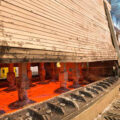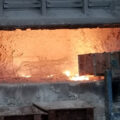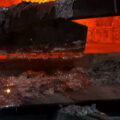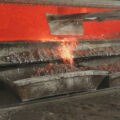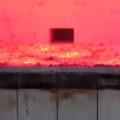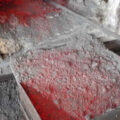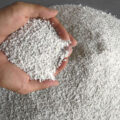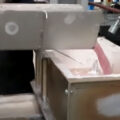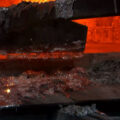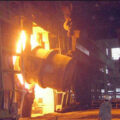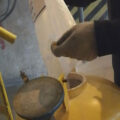Aluminum Refining in Furnace is an important step in aluminum casting. The reasons why the molten aluminum in the holding furnace needs to be refined mainly include the following four aspects:
First, before casting, it is necessary to ensure that the hydrogen content of the molten aluminum meets the requirements of the final product. With the different feeding types of the smelting furnace and the different smelting temperature, the hydrogen content of molten aluminum after smelting is different, but it is much higher than the required index of the final casting product. Relying on the online degassing unit alone is difficult to meet the requirements, which requires the molten aluminum refining in furnace to reduce the hydrogen content and create conditions for online purification.
Second, there is a large drop between the molten aluminum inlet of the holding furnace and the inverted launder. For the holding furnace with a capacity of 85t, the drop is usually 1100m. The drop varies according to the capacity of the holding furnace. The greater the capacity of the holding furnace, the greater the drop. The reason is that the depth of the molten pool increases as the volume of the molten aluminum increases. This will cause impact and splashing when the molten aluminum enters the holding furnace through the inverted furnace launder, and the aluminum liquid absorbs hydrogen twice and the hydrogen content increases.
Third, hydrogen is a gas that is very easy to dissolve into aluminum and aluminum alloys. The solubility of hydrogen is affected by the temperature of the molten aluminum. The higher the molten aluminum temperature, the more obvious the tendency to absorb hydrogen. When feeding the smelting furnace, in order to save energy, reduce fuel consumption, and reduce the smelting time, the electrolytic aluminum liquid and the original aluminum ingot are used to mix and feed. Due to the characteristics of the electrolytic aluminum liquid itself, that is, the temperature is higher than 800℃, which leads to a high gas inhalation of the electrolytic aluminum liquid, and the hydrogen content sometimes exceeds 0.500ml/100g. The hydrogen content of the molten aluminum poured into the holding furnace at the end of smelting far exceeds the index required for casting.
Fourth, for molten aluminum with high content of alkali metals Li, Na, K, it is necessary to add Cl2 to refining the molten aluminum to remove the alkali metals and improve the mechanical properties of the material. At the same time, the nature of the oxide film directly affects the hydrogen content of the aluminum liquid. The oxide film is closely related to the alkali metal elements. The chemical properties of the alkali metal elements are active and enriched on the surface of the aluminum liquid, which loosens the oxide film and promotes the hydrogen absorption of the aluminum liquid, for example, the hydrogen content of AI-Li alloy can reach 10 times that of general aluminum alloy.
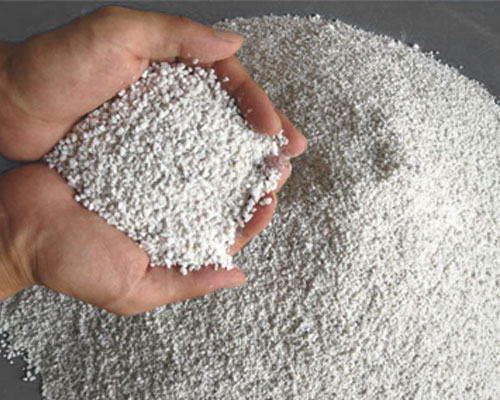
Based on the above four reasons, the molten aluminum refining in furnace is necessary, so that the hydrogen content of the molten aluminum will reach 0.250ml/100g or less before entering the online degassing system from the holding furnace, which creates conditions for the online refining unit to meet the requirements of the casting product.
There are two conventional methods for refining molten aluminum in the holding furnace, one is adding a refining agent, and the other is refining with CCl4.
The main components of the refining agent are NaCl, NaF, KC1, etc., and the melting point of the refining agent is lower than the eutectic temperature of NaC1 and KC1 at 665 ℃, and lower than the melting temperature of aluminum alloy. The main principle of the refining agent is to use the wetting properties of these salt fluxes to wet the oxide inclusions in the molten aluminum, and then float to the surface of the molten aluminum to be removed. Because the oxidized inclusions and hydrogen in the aluminum liquid are parasitic and affect each other. With the reduction of oxidized inclusions, the hydrogen content of the molten aluminum decreases, so in the process of removing the inclusions, part of the hydrogen in the molten aluminum can be removed. The main principle of using CCL4 refining is to use the Cl2 produced by the decomposition of CCl4. Due to the partial pressure difference of hydrogen inside and outside the Cl2 bubble, hydrogen enters the bubble and is carried out by the bubble during the floating process to reduce the hydrogen content in the aluminum liquid. In addition, Cl2 The chemical reaction with alkali metals reduces the alkali metal content.

